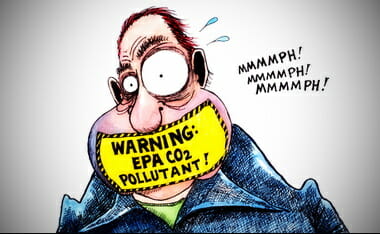
A must read article from the City-Journal:
In February 2013, Utah governor Gary Herbert canceled plans to establish a state-run exchange for individual health insurance, bringing to 34 the number of states opting out of that essential piece of the Affordable Care Act. Meanwhile, another part of the law, an expansion of Medicaid rolls, is being defied by more than 20 states. Having survived congressional logrolling, Tea Party rallies, a presidential election, and a Supreme Court case, Obamacare may yet be sunk by a resurgent force that many had thought dead: federalism.
The new federalist fervor is coming from both sides of the aisle. Among the governors refusing to create state health-insurance exchanges are two Democrats (in Missouri and Montana), while the Democratic governor of President Obama’s home state, Illinois, is willing only to “partner” with the federal government in setting up an exchange. Nor is the resistance limited to Obamacare. Last November, California’s Democratic governor, Jerry Brown, warned “federal gendarmes” to stop interfering with his state’s medical-marijuana law—echoing former Massachusetts representative Barney Frank, who had championed medical marijuana as a states’ rights issue for years. Such deep-blue states as New York and Massachusetts have tried (unsuccessfully) to block the Secure Communities Act, which requires every arrested person’s fingerprints to be run through federal immigration databases. The Democratic governor of locavore Vermont is locked in a battle with the feds over who gets to determine the future of the Vermont Yankee Nuclear Power Plant: the state legislature or the presidential appointees on the Nuclear Regulatory Commission. In March 2012, Yale law professor Heather Gerken took to the pages of Democracy to urge her fellow progressives to embrace federalism because state and local governments were more effective “sites of empowerment for racial minorities and dissenters” than the federal government.
Conservatives may still be the most vocal advocates of greater state autonomy, but federalism is far from a uniquely conservative phenomenon. Indeed, the revival of states’ rights is a movement that has the potential to unite Left and Right while fundamentally changing the balance of power in America.
Political scientists divide American federalism—broadly speaking, the system that divides sovereignty between the federal government and the states—into three eras: dual, cooperative, and coercive. Dual federalism, which lasted from 1789 until the New Deal, reflected the Founders’ original understanding of the state and federal governments as joint sovereigns, each supreme within its own sphere. Article I of the Constitution grants Congress relatively few powers, relating to defense, tariffs, and the like. The Tenth Amendment, added in 1791, clarifies that the states and the people retain all powers not delegated to the central government. Even before the Tenth Amendment, however, James Madison observed in Federalist 45 that the Constitution gave states nearly complete power to pass and enforce laws touching on “the lives, liberties, and properties of the people, and the internal order, improvement, and prosperity of the State.” Realizing that individual liberty is at risk whenever political power becomes concentrated in one level or one branch of government, the Constitution’s framers considered federalism, together with the separation of powers, a far more important safeguard of freedom than the Bill of Rights.
During the era of dual federalism, the national government focused on its constitutional duties while the state and local governments tended to the safety and welfare of their residents. The debates of the time would seem quaint today, such as the controversy that raged over Congress’s authority to subsidize infrastructure projects; as president, Madison vetoed a bill providing for roads, canals, and other “internal improvements” as beyond the powers of the federal government. At the end of the nineteenth century, the British historian Lord Acton credited America’s division of power with producing “a community more powerful, more prosperous, more intelligent, and more free than any other the world has seen.”
Franklin Roosevelt’s New Deal put an end to dual federalism. At first, the Supreme Court killed off a number of the president’s new programs, but after FDR threatened to install six additional pro-administration justices, it began to change course. In the 1941 case United States v. Darby, which upheld the federal takeover of wage and hour laws, the Court brushed aside the Tenth Amendment as a mere “truism” that didn’t limit the scope of Congress’s powers. Thus was born the era of cooperative federalism, characterized by “a constantly increasing concentration of power at Washington in the stimulation and supervision of local policies,” as FDR advisor Edward Corwin put it. Notwithstanding the federal encroachment on their turf, states often welcomed the new federal programs because they were accompanied by unprecedented grants. Those grants were subject to relatively few conditions; instead, the federal government treated the states as partners in implementing national policy and gave state officials considerable flexibility in carrying out their roles.
The cooperative model began to break down in the 1960s, as Congress attached ever more specific and intrusive conditions to federal aid. The Highway Beautification Act of 1965, for example, told states to follow federal rules for regulating billboards or lose 10 percent of their highway funding. By the 1970s, such conditional grants, combined with unfunded mandates—marching orders that the federal government issues but doesn’t pay for—created the model that persists to this day: coercive federalism.
…read more…





